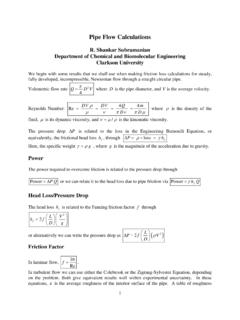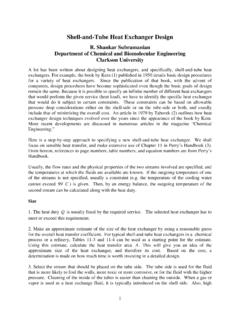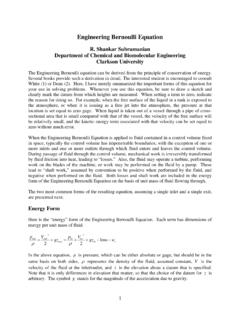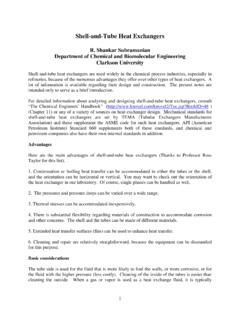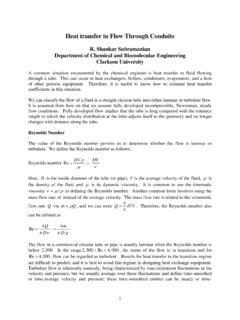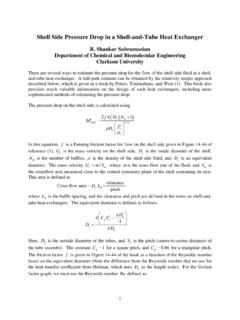Transcription of Pipe Flow Calculations - Clarkson University
1 1 pipe Flow Calculations R. Shankar Subramanian Department of Chemical and Biomolecular Engineering Clarkson University We begin with some results that we shall use when making friction loss Calculations for steady, fully developed, incompressible, Newtonian flow through a straight circular pipe . Volumetric flow rate 24 QDV = where D is the pipe diameter, and Vis the average velocity. Reynolds Number: 44 ReDVDVQmDD ==== where is the density of the fluid, is its dynamic viscosity, and / = is the kinematic viscosity. The pressure drop P is related to the loss in the Engineering Bernoulli Equation, or equivalently, the frictional head loss fh, through lossfPh = = Here, the specific weight g =, where g is the magnitude of the acceleration due to gravity.
2 Power The power required to overcome friction is related to the pressure drop through PowerPQ= or we can relate it to the head loss due to pipe friction via PowerfhQ = Head Loss/Pressure Drop The head loss fh is related to the Fanning friction factor f through 22fLVhfDg = or alternatively we can write the pressure drop as ()22 LPfVD = Friction Factor In laminar flow, 16 Ref=. In turbulent flow we can use either the Colebrook or the Zigrang-Sylvester Equation, depending on the problem. Both give equivalent results well within experimental uncertainty.
3 In these equations, is the average roughness of the interior surface of the pipe . A table of roughness 2 values recommended for commercial pipes given in a textbook on Fluid Mechanics by White is provided at the end of these notes. Colebrook Equation 101 = + Zigrang-Sylvester Equation 10101 = + Non-Circular Conduits Not all flow conduits are circular pipes. An example of a non-circular cross-section in heat exchanger applications is an annulus, which is the region between two circular pipes.
4 Another is a rectangular duct, used in HVAC (Heating, Ventilation, and Air-Conditioning) applications. Less common are ducts of triangular or elliptical cross-sections, but they are used on occasion. In all these cases, when the flow is turbulent, we use the same friction factor correlations that are used for circular pipes, substituting an equivalent diameter for the pipe diameter. The equivalent diameter eD, which is set equal to four times the Hydraulic Radius, hRis defined as follows. Cross - Sectional Area44 Wetted PerimeterehDR= = In this definition, the term wetted perimeter is used to designate the perimeter of the cross-section that is in contact with the flowing fluid.
5 This applies to a liquid that occupies part of a conduit, as in sewer lines carrying waste-water, or a creek or river. If a gas flows through a conduit, the entire perimeter is wetted. Using the above definition, we arrive at the following results for the equivalent diameter for two common cross-sections. We assume that the entire perimeter is wetted. Rectangular Duct For the duct shown in the sketch, the cross-sectional area is ab, while the perimeter is ()2ab+ so that the equivalent diameter is written as follows. ab3 24112()eabDabab= =+ + If the flow is laminar, a result similar to that for circular tubes is available for the friction factor, which can be written as / RefC=, where C is a constant that depends on the aspect ratio /ab, and the Reynolds number is defined using the equivalent diameter.
6 A few values of the constant C for selected values of the aspect ratio are given in the Table below (Source: White, Fluid Mechanics, 7th Edition). For other aspect ratios, you can use interpolation. /ab C /ab C Annulus The cross-sectional area of the annulus shown is ()22ab , while the wetted perimeter is ()2ab +. Therefore, the equivalent diameter is obtained as ()()()22422eabDabab == + Again, for laminar flow, we find that / RefC=, where C is a constant that depends on the aspect ratio /ab, and the Reynolds number is defined using the equivalent diameter.
7 As with the rectangular cross-section, a few values constant C for selected values of the aspect ratio are given in the Table that follows (Source: White, Fluid Mechanics, 7th Edition). For other aspect ratios, you can use interpolation. ab4 /ab C /ab C 10,0 100 1000 Minor Losses Minor losses is a term used to describe losses that occur in fittings, expansions, contractions, and the like. Fittings commonly used in the industry include bends, tees, elbows, unions, and of course, valves used to control flow.
8 Even though these losses are called minor, they can be substantial compared to those for flow through short straight pipe segments. Losses are commonly reported in velocity heads. A velocity head is ( )2/2Vg. Therefore, we can write minor losses as 22mLVhKg=, where LK is called the loss coefficient. Typical values of LK for some common fittings are given below. Usually, the values depend upon the nominal pipe diameter, the Reynolds number, and the manner in which the valve is installed (screwed or flanged).
9 Manufacturers data should be used wherever possible. Globe Valve (fully open): - 14 Gate Valve (fully open): - Swing Check Valve (fully open): - Standard 45o Elbow: - Long radius 45o Elbow: - Standard 90o Elbow: - Long radius 90o Elbow: - Tee: - When solving homework problems, use the values given in Table in the textbook by Welty et al. Sudden Expansion and Sudden Contraction A sudden expansion in a pipe is one of the few cases where the losses can be obtained from the basic balances. The expression for LK is given by 2221 LdKD = 5 Here, d and D represent the diameters of the smaller and larger pipes, respectively.
10 For a sudden contraction, we can use the same result if . For smaller values of /dD we can use the empirical relation 1/LKdD = . In both cases, we should multiply LK by the velocity head in the pipe segment of diameter d. The losses would be smaller if the expansion or contraction is gradual. When a pipe empties into a reservoir, all the kinetic energy in the fluid coming in is dissipated, so that you can treat this as a sudden expansion with the ratio /0dD=, yielding 1LK=. Typical pipe Flow Problems In typical pipe flow problems, we know the nature of the fluid that will flow through the pipe , and the temperature.
